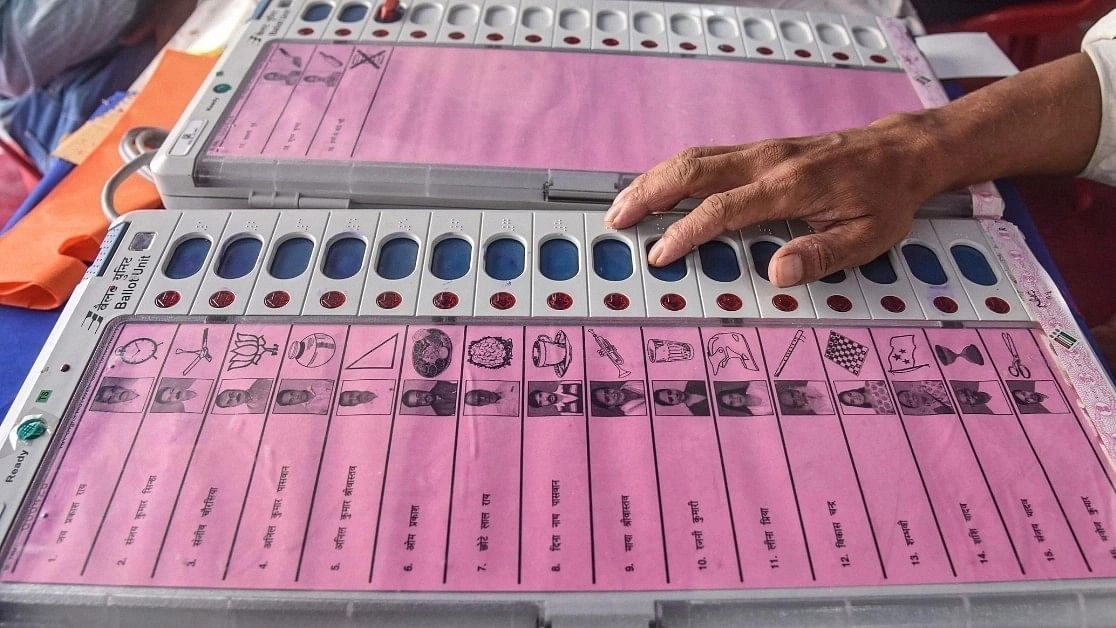
Representative image of a person casting a vote.
Credit: PTI Photo
By Matt Qvortrup for The Conversation
Coventry, United Kingdom: The British electorate has been more volatile than ever in recent years. The elections of 2015 and 2017 saw the highest number of voters switching parties in modern history. And current polling suggests we’re about to see more of the same.
Understanding what’s happening in people’s brains when they are making decisions helps us understand why certain political messages appeal to them and why they might decide to switch parties.
Political scientists talk about Pedersen volatility, named after the distinguished Danish scholar Mogens N Pedersen. There is a forbidding mathematical equation for this, but it all amounts to “the net change within the electoral party system resulting from individual vote transfers”.
In plain English, volatility is simply the number of people who change party in an election. In late 1960s Britain, the Pedersen index stood at just over 10 per cent, now it is closer to 40 per cent.
There has been much talk about the increased use of social media and its influence on election outcomes. A recent study by Professor Hanspeter Kreisi, a Swiss election expert, reported that “a steady stream of argument and voting cues [are] allowing voters to make enlightened choices that are in line with their preferences”.
This might well be true, but a recent study found that while politicians post more on social media during election campaigns, overall, the number of posts with policy content is lower not higher.
The voting brain
One of the more interesting developments in electoral studies is that we are now able to use social neuroscience methods to understand voting behaviour.
In the past decade, neuroscience has enabled us to identify the parts of the brain that get activated when you watch political adverts. What these results show is that most people are driven by fear and emotion rather than by rational argument in election campaigns.
In practice, this means that voters are more susceptible to messages that stress the negative rather than the positive. Researchers found that negative images and statements about products led to heightened activity in the dorsolateral prefrontal cortex, which is also associated with decision making.
For example, negative information about a brand of cola made subjects more likely to buy the competing brand. However, when this experiment was repeated with political parties rather than soft drinks, the negative effect was three times higher. Negative political advertising works, and we now have the fMRI scans to prove it.
Politics is a bare-knuckle fight, and our brains reflect that. Evolution has conditioned us to be driven by fear when we are under threat. We want to survive above all.
By playing on our fear and anger, those who devise election slogans are producing – perhaps deliberately – messaging that triggers parts of the brain associated with revenge and pent-up rage, including the so-called anterior cingulate cortex (or ACC), deep in the front part of the fissure that separates the two brain-hemispheres. So, if I am furious that Rishi Sunak has not brought NHS waiting lists down, it is likely that the ACC has gone into overdrive.
Older people – who tend to vote in higher numbers – are particularly interesting here. This is because as we age, we become more prone to activating the so-called dorsolateral prefrontal cortex – an area of the brain associated with caution.
It is unlikely that Rishi Sunak has delved into the finer points of neuropolitics but his strategy is consistent with what we know from social neuroscience. His emphasis on need to “stick to the plan” and not gamble on the opposition appeals to those with oversensitive dorsolateral prefrontal cortices – namely the older voter cohort he most needs to convince.
But more broadly, people of all ages have a strong tendency to activate the amygdala – a part of the brain associated with fear. Only rarely do we activate the parts of the brain associated with ethical evaluation such as the so-called ventromedial prefrontal cortex.
No wonder the two main parties in the British election are focusing on fear and caution. Maybe Machiavelli got it right when he observed that voters are “avoiders of danger”? Appealing to this fear, we see Rishi Sunak repeatedly warning in a very unspecified way that the world is more “dangerous” than ever.
And clearly realising that voters respond to promises of security, the two parties are labelling policies as a “triple lock”, be it on pensions or the nuclear deterrent.
The age of economic voting
The other rich seam of academic research on why voters change their minds relates to the knowledge that since the 1970s or so, voters have been more prone to base their decisions on macroeconomic performance. Thus, political parties that have presided over significant financial downturns get blamed.
This explains why the Conservatives lost in 1992 and Labour lost in 1979. Voters even change their minds based on recent economic performance even if the economic downturn is beyond the control of the government, as was the case for former Conservative prime minister Edward Heath, who lost power after the 1973 oil crisis (precipitated by a war in the Middle East).
Once a government has been associated with economic ills – increases in mortgage rates, cost of living and the like – they get blamed even if the economy is in recovery.
The current government’s slogan that the plan is working might be economically correct, but history suggests it will not prevent voters from changing parties.
(Matt Qvortrup is a chair of Applied Political Science at the Coventry University.)